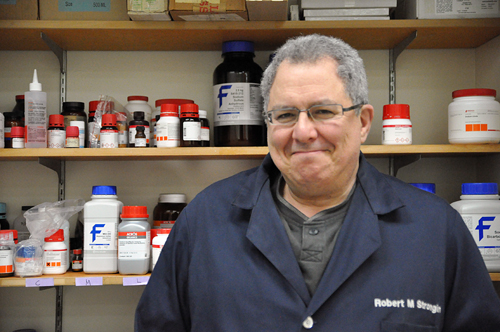Portland State professor of chemistry Robert Strongin and his research team have patented a specific type of dye technology that can be used to test for a variety of diseases. PSU has partnered with a diagnostics company based out of Colorado to develop the dye into a specialized medical test.
PSU professor partners with diagnostics company to create medical test

Portland State professor of chemistry Robert Strongin and his research team have patented a specific type of dye technology that can be used to test for a variety of diseases. PSU has partnered with a diagnostics company based out of Colorado to develop the dye into a specialized medical test.
Strongin, who has worked at PSU since April 2007, and his research team have created a type of dye that can detect elevated levels of homocysteine in blood plasma.
According to PSU post-doctoral student and project researcher Jorge Escobedo, homocysteine is a type of amino acid produced by the human body. Escobedo said that high levels of the homocysteine molecule are indicators that one’s metabolic system is not functioning properly. Elevated homocysteine has been linked to many health issues including cardiovascular diseases, Alzheimer’s disease, osteoporosis and birth defects.
“The dye is equivalent to a PH or pregnancy test,” Strongin said. When no homocysteine is detected in a blood plasma sample, the result is a clear, colorless solution in a test tube; however, when homocysteine is present, the dye reacts and the solution turns a bright blue color.
While this type of testing technology is not new—Strongin and Escobedo have been working with viologen dye since 2003—this version of the dye is by far the simplest to use and most streamlined. According to Strongin, this dye technology is superior to current testing methods for homocysteine molecules for several reasons.
First, the dye is extremely stable. Unlike other tests currently used by doctors, Strongin’s patented dye is easy to store and does not degrade over time. Another significant benefit to this technology is its readability; the dye gives a very clear indication of whether or not homocysteine is present in the sample by distinctly changing color.
The current testing method used to detect levels of homocysteine is also quite expensive, making it unfavorable to doctors, but Strongin said that his dye technology will be significantly less expensive due to its utilization of fewer biological materials.
Boulder Diagnostics, a medical diagnostics company based out of Boulder, Colo., is interested in adapting the discoveries made at PSU into a simple medical testing device that can be used by doctors, hospitals and medical laboratories.
Boulder Diagnostics’ scientific consultant, Dr. Roy Mondesire, commented that Boulder is interested in the dye because it is affordable, as well as the simplest test of its kind.
“Strongin’s dyes are designed to be exquisitely sensitive and specific for various target molecules,” Mondesire said. Both Mondesire and Escobedo observed that this dye is unique because it is selective. It can hone in on homocysteine alone, while comparable tests require extra steps to filter out other molecules that are found in blood plasma.
Strongin believes that if Boulder Diagnostics is successful in creating a user-friendly testing device, the dye technology he researched could be extremely beneficial to health professionals in developing countries.
Because the dye is so easy to use, store and read, doctors without access to dependable refrigeration and electrical power sources—as is often the case in third-world clinics—can still count on the test to be accurate.
Strongin and his team of PSU researchers have created the dye technology, but they do not have the physical means to administer it to a real patient. Boulder’s role will be to build the actual product that will reach the medical market.
“Diagnostic devices that employ the dyes can be easily adapted to point-of-care testing,” Mondesire said.
The project does require further tweaking before the dye appears in hospitals and clinics around the world. While lab results have been promising, the dye still needs to be tested in a clinical setting and has to be compared to more expensive tests.
“Well, nothing is perfect. The dye still requires extensive validation in patient samples. We only know what happens in the lab,” Strongin said.
Meanwhile, Strongin and his team are working to create more dyes that can detect different biomarkers for other diseases. Escobedo commented that creating a dye that is preventive in nature is especially rewarding, because it could potentially help save lives.
Strongin hopes that the partnership with Boulder Diagnostics can extend well into the future. “Having a company to partner with is really great because it gets your discoveries out into the world,” he said.
Strongin also said that as his team develops more dyes, Boulder could also create more testing devices to help diagnose a wider range of diseases—a partnership which both parties see as promising.
“Dr. Strongin’s impressive studies and contributions to fundamental chemistry have already had a major positive impact on several human diseases,” Mondesire said.


